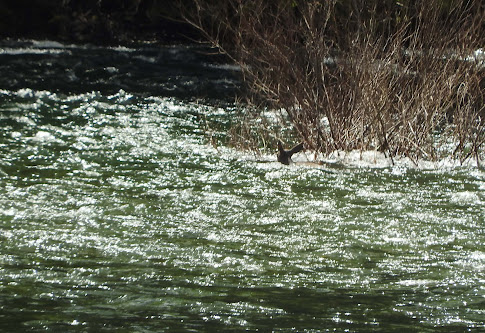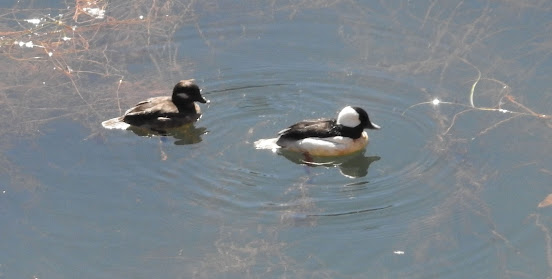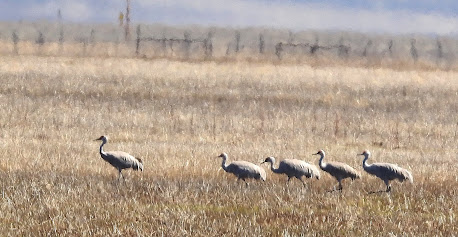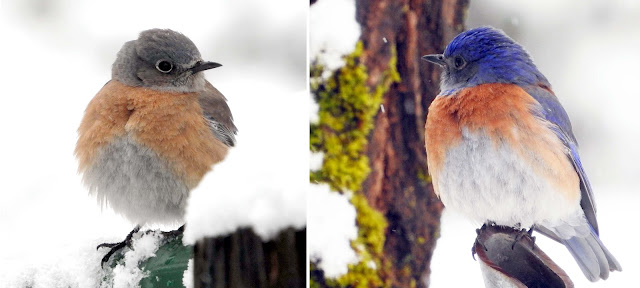We just had a very rainy week, with a total of 3.35" of rain, and it's still raining today. This brings our water year total to 44.46"! The river is up, at 5.5', and flowing fast at 1600cfs (cubic feet per second). The water is a chilly 40 degrees!
North Yuba River - 3/26/24
Almost everyday, I linger on our bridge and check out what's happening on the river. This week, to my surprise and alarm there was an adult doe being swept downriver by the fast highwater! Sometimes her back was showing and sometimes it was totally submerged!
Mule Deer (doe) in the North Yuba River
In less than 30 seconds the doe was carried downriver as far as I could watch her, and then disappeared around the river bend! WOW! I kept hoping that she would veer off and get out of the river, but the current must have been too fast. Hopefully she got out soon after I lost sight of her!
Mule Deer (doe) in the North Yuba River
I wondered what had made her go into the river. Perhaps she was being pursued by a Mountain Lion or a dog. I even drove down the highway looking for her, but didn't see her. I sure hope she made it. My neighbor told me that he has seen deer in the river many times during winter! One time he was upriver where the river gets narrow, fast, and rushes down between huge boulders. He saw a deer enter the river, get flipped over by the current, and washed down river upside down through the boulders! When the river flattened out, the deer righted itself and then scrambled up the riverbank! Wow! They must be way tougher than I thought!
American Dipper nest - American Dipper
On another part of the river I've been observing an American Dipper nest for the past few weeks. To my surprise and alarm, when I went to check it out yesterday the nest was GONE and the American Dipper was sitting on the ledge all by itself!!! WHAT??? I had stopped to see the nest about 4 days before, and I remembered that there had been two Common Ravens in the immediate vicinity that day. The river is way too high and fast for any humans to disturb the nest right now. So I think that maybe the Ravens investigated the nest to eat the eggs, and knocked it off the ledge in the process!!! I'm glad the Dipper is still okay despite the destruction of its nest. It will be interesting to see if it makes a new nest. I hope it does, but maybe not at such an obvious location! I also hope the Ravens stay away if it does!!! Life is tough out there in the wild.
Joubert's Diggins
Local Pond Update
Since it's been too rainy to hike I decided to drive and visit the three local ponds I watch in the winter. At Joubert's Diggins, the usual Buffleheads and Hooded Mergansers were still in residence, but there were some new arrivals including a Common Goldeneye and a pair of Mallards! I have not yet seen any Wood Ducks there, but maybe they'll show up in the near future.
Buffleheads (female-male) - Bucephala albeola
There's a population of about ten Buffleheads on these ponds.
Common Goldeneye (female) - Bucephala clangula
Interestingly there was only one Common Goldeneye on the ponds, but it was the first one I've ever seen there!
Hooded Mergansers (female-male) - Lophodytes cucullatus
So far I've only seen this one pair of Hooded Mergansers on the ponds.
Mallards (male-female) - Anas platyrhynchos
Only the Mallards will stay and raise their young here.
Charles Marsh Pond
Surprisingly at the Charles Marsh Pond there was only one duck visible, a female Hooded Merganser! All winter longer there has been a population of 8 Hooded Mergansers on this pond!
Hooded Mergansers (female) - Lophodytes cucullatus
Wood Duck Pond - 3/28/24
Wood Duck Pond was inhabited by only a pair of Wood Ducks! I felt privileged to see this pair of beauties once again!
Wood Ducks (female - male) - Aix sponsa
Mendocino Silk Moth - Calosturnia mendocino
This super unusual looking moth turned out to be a Mendocino Silk Moth - Calosturnia mendocino. Bugguide.net identified it for me! This is a female and measures 61mm. Males aren't as big as the females, and measure 50mm. The following information is about their behavior and habitat is from butterfliesandmoths.org
"Life History: Adults fly in the daytime with a fast and erratic flight. Newly-emerged females fly only after they have mated. Females lay eggs singly or in bunches of 2-6 on the leaves of the host plants. Eggs hatch 1 to 7 weeks later. Loose mesh-like cocoons are attached to stems or branches of the host plants.
Flight: One brood from February-June.
Caterpillar Hosts: Manzanita (Arctostaphylos) and madrone (Arbutus menziesii), both in the heath family (Ericaceae).
Adult Food: Adults do not feed.
Habitat: Chaparral plant communities and the dry edges of redwood forests.
Range: Monterey County, California north through the Coast Range and from Tulare County on the western slopes of the California Sierra Nevada, north through the Cascade Mountains and into southern Oregon."
Sierra Buttes - 3/21/24
Up in the Lakes Basin
Just before the week of rain came in, my friend Diane and I hiked/skied up to Upper Sardine Lake! There was about 1.5' of packed snow on the roads, so she skied and I walked. It was a beautiful clear blue-sky day without a cloud in sight. A gorgeous day to be back in the Lakes Basin!
Lower Sardine Lake - 3/21/24
Both of the lakes were still frozen, except for a little thawing on the edge.
Upper Sardine Lake - 3/21/24
The road to Upper Sardine Lake hadn't been driven on
and wasn't packed down. So we punched in the whole way up to the lake and back, and definitely got our exercise! The view of the lake was well worth the effort! I hadn't been up to the lake in winter since 2021!
Mountain Chickadee - Poecile gambeli
Although there were lots of tracks we didn't see any wild mammals. I did however enjoy a moment with this cute little Mountain Chickadee, whose song was such a familiar "Dee dee dee"!
Table Mountain and the Sutter Buttes
What's happening in the foothills?
What new birds will arrive this week?
Check back next week for the answers to these questions and more!
Your questions and comments are greatly appreciated! Please email me at northyubanaturalist@gmail.com. Thanks!














































.jpg)




